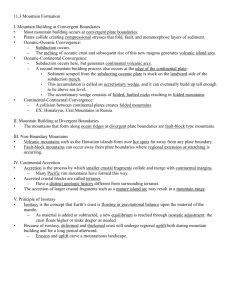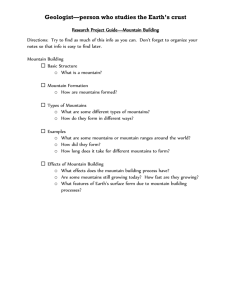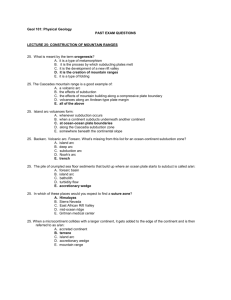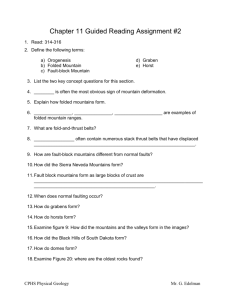Mountain Building Mountain Building
advertisement
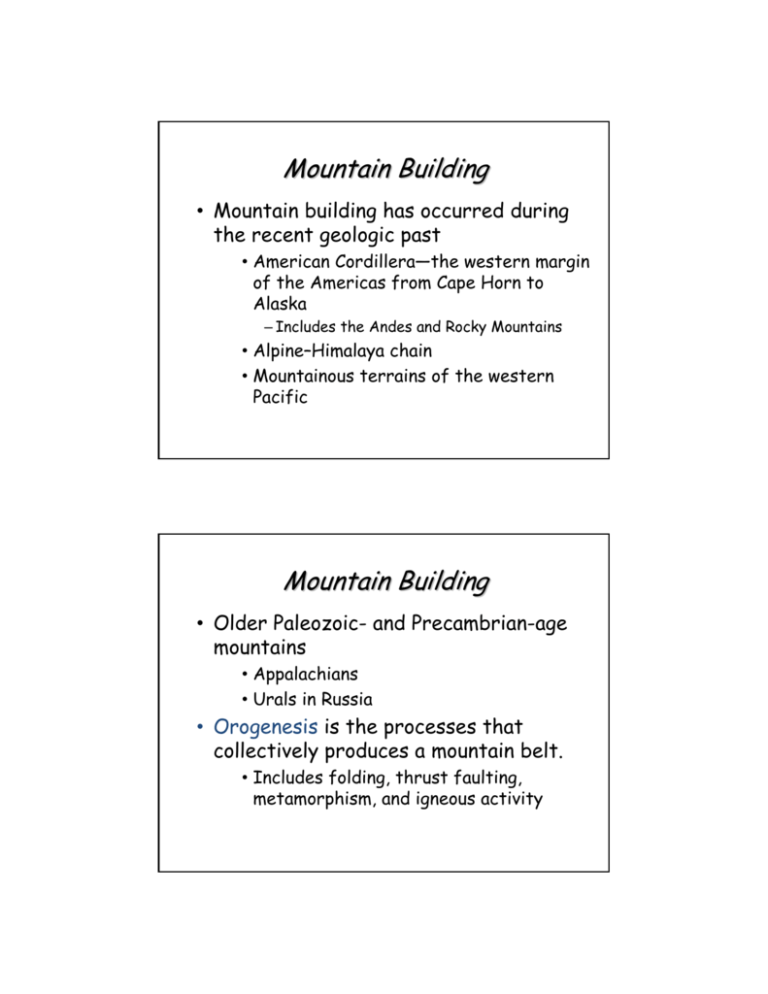
Mountain Building • Mountain building has occurred during the recent geologic past • American Cordillera—the western margin of the Americas from Cape Horn to Alaska – Includes the Andes and Rocky Mountains • Alpine–Himalaya chain • Mountainous terrains of the western Pacific Mountain Building • Older Paleozoic- and Precambrian-age mountains • Appalachians • Urals in Russia • Orogenesis is the processes that collectively produces a mountain belt. • Includes folding, thrust faulting, metamorphism, and igneous activity How do mountains form? Mountain Building • Several hypotheses have been proposed for the formations of Earth’s mountain belts • None explain all observations as well as plate tectonics • Most – but not all – mountain building occurs at convergent plate boundaries Earth’s Major Mountain Belts Creating a Mountain Two mechanisms shown here •Hot spot activity •Subduction creating island arc Convergence and Subducting Plates • Major features of subduction zones • Deep-ocean trench—a region where subducting oceanic lithosphere bends and descends into the asthenosphere • Volcanic arc—built upon the overlying plate – Island arc if on the ocean floor or – Continental volcanic arc if oceanic lithosphere is subducted beneath a continental block The Aleutian Volcanic Island Arc Subduction and Mountain Building • Island arc mountain building • Where two ocean plates converge and one is subducted beneath the other • Volcanic island arcs result from the steady subduction of oceanic lithosphere – Continued development can result in the formation of mountainous topography consisting of igneous and metamorphic rocks Ocean–Ocean Island arcs: • Tectonic belts of high seismic activity • High heat flow arc of active volcanoes (andesitic) • Bordered by a submarine trench Ocean–Ocean Subduction Zone Island arc Ocean–Continent Continental arcs: • Active volcanoes (andesite to rhyolite) • Often accompanied by compression of upper crust Ocean–Continent Convergent Boundaries Breadth of arc-trench gap Breadth of arc-trench gap Subduction and Mountain Building • Andean-type mountain building • Mountain building along continental margins • Involves the convergence of an oceanic plate and a plate whose leading edge contains continental crust – Exemplified by the Andes Mountains Ocean-Continent Subduction Zone Continental volcanic arc Subduction and Mountain Building • Andean-type mountain building • Building a continental volcanic arc – Subduction and partial melting of mantle rock generate primary magmas – Magma is less dense than surrounding rock, so it begins to buoyantly rise – Differentiation of magma produces andesitic volcanism dominated by pyroclastics and lavas Subduction and Mountain Building • Andean-type mountain building • Emplacement of plutons – Thick continental crust impedes the ascent of magma – A large percentage of the magma never reaches the surface and is emplaced as plutons – Uplift and erosion exposes these massive structures called batholiths (i.e., the Sierra Nevada in California and the Peruvian Andes) – Batholiths are typically intermediate to felsic compositions Andean-Type Plate Margin Subduction and Mountain Building • Andean-type mountain building • Development of an accretionary wedge – An accretionary wedge is a chaotic accumulation of deformed and thrustfaulted sediments and scraps of oceanic crust – Prolonged subduction may thicken an accretionary wedge enough so that it protrudes above sea level – Descending sediments are metamorphosed into a suite of high-pressure, lowtemperature minerals Subduction and Mountain Building • Andean-type mountain building • Forearc basin – The growing accretionary wedge acts as a barrier to sediment movement from the arc to the trench – This region of relatively undeformed layers of sediment and sedimentary rock is called a forearc basin Parts of an Ocean–Ocean Convergent Plate Boundary Subduction and Mountain Building • The Sierra Nevada and the Coast Ranges • One of the best examples of an active Andean-type orogenic belt • Subduction of the Pacific basin under the western edge of the North American plate • The Sierra Nevada batholith is a remnant of a portion of the continental volcanic arc • The Franciscan Formation of California’s Coast Ranges constitutes the accretionary wedge Mountains and Landforms of the Western United States Convergence and Subducting Plates • Major features of subduction zones • The forearc region is the area between the trench and the volcanic arc • The backarc region is located on the side of the volcanic arc opposite the trench Convergence and Subducting Plates • Dynamics at subduction zones • Extension and backarc spreading – As the subducting plate sinks, it creates a flow in the asthenosphere that pulls the upper plate toward the trench – Tension and thinning may produce a backarc basin Continental Collisions • Two lithospheric plates, both carrying continental crust • Continental collisions result in the development of compressional mountains that are characterized by shortened and thickened crust • Most compressional mountains exhibit a region of intense folding and thrust faulting called a fold-and-thrust belt • The zone where the two continents collide is called the suture Major Features of a Compressional Mountain Belt Terranes • Geologically distinctive regions of Earth’s crust, each of which has behaved as a coherent crustal block Terranes and Mountain Building • Another mechanism of orogenesis • The nature of terranes • Small crustal fragments collide and merge with continental margins • Accreted crustal blocks are called terranes (any crustal fragments whose geologic history is distinct from that of the adjoining terranes) Approaching Arc or Microcontinent Collision Accreted Microplate Terrane Terranes and Mountain Building • The nature of terranes • Prior to accretion, some of the fragments may have been microcontinents • Others may have been island arcs, submerged crustal fragments, extinct volcanic islands, or submerged oceanic plateaus Terranes and Mountain Building • Accretion and orogenesis • As oceanic plates move, they carry embedded oceanic plateaus, island arcs, and microcontinents to Andean-type subduction zones • Thick oceanic plates carrying oceanic plateaus or “lighter” igneous rocks of island arcs may be too buoyant to subduct Terranes and Mountain Building • Accretion and orogenesis • Collision of the fragments with the continental margin deforms both blocks, adding to the zone of deformation and to the thickness of the continental margin • Many of the terranes found in the North American Cordillera were once scattered throughout the eastern Pacific Microplate terranes added to western North America over the past 200 million years Continental Collisions • The Appalachian Mountains • Formed long ago and substantially lowered by erosion • Resulted from a collision among North America, Europe, and northern Africa • Final orogeny occurred about 250 million to 300 million years ago Appalachian Mountains Fault-Block Mountains • Continental rifting can produce uplift and the formation of mountains known as fault-block mountains • Fault-block mountains are bounded by high-angle normal faults that flatten with depth • Examples include parts of the Sierra Nevada of California and the Grand Tetons of Wyoming The Teton Range in Wyoming Are Fault-Block Mountains Fault-Block Mountains • Basin and Range Province • One of the largest regions of faultblock mountains on Earth • Tilting of these faulted structures has produced nearly parallel mountain ranges that average 80 kilometers in length • Extension beginning 20 million years ago has stretched the crust twice its original width Fault-Block Mountains • Basin and Range Province • High heat flow and several episodes of volcanism provide evidence that mantle upwelling caused doming of the crust and subsequent extension The Basin and Range Province Vertical Movements of the Crust • Isostasy • Less dense crust floats on top of the denser and deformable rocks of the mantle • Concept of floating crust in gravitational balance is called isostasy • If weight is added or removed from the crust, isostatic adjustment will take place as the crust subsides or rebounds The Principle of Isostasy Vertical Movements of the Crust • Vertical motions and mantle convection • Buoyancy of hot rising mantle material accounts for broad upwarping in the overlying lithosphere • Uplifting whole continents – Southern Africa • Crustal rebound – Regions once covered by ice during the last Ice Age – Ice melts, crustal rebound and uplift Uplift Formed by Removal of Ice Sheet Raised Beaches Due to Isostatic Uplift Continental Collisions • The Himalayan Mountains • Youthful mountains—collision began about 45 million years ago • India collided with Eurasian plate • Similar but older collision occurred when the European continent collided with the Asian continent to produce the Ural Mountains Formation of the Himalayas Tibet—not just mountains, a huge plateau too Continent–Continent Convergent Boundary Indian plate subducts beneath Eurasian plate 60 million years ago Indian subcontinent collides with Tibet 40–60 million years ago Accretionary wedge and forearc deposits thrust northward onto Tibet Approximately 40–20 million years ago Main boundary fault develops 10–20 million years ago India has collided with Asia Exotic terranes Faults galore… …and earthquakes Focal mechanisms Thrust Strikeslip Normal Normal faults in the plateau mean E-W extension Himalayan collision ideas A complicated explanation emerges The drooling lithosphere So now we think we have figured it out Indian climate before Himalayas Monsoon Climate: Tibet heats up and air rises Moist Indian Ocean air sucked in Clouds form as moist air blocked by mountains
